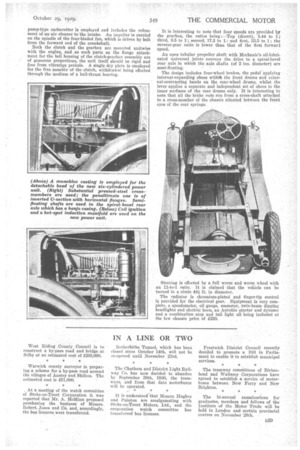WILLYSOVERLANDCROSSLEY DEVELOPMENTS
Page 90

Page 91

If you've noticed an error in this article please click here to report it so we can fix it.
COMMEXCIAL chassis nowadays are being treated much in the same manner as private cars, for refinement in running, speed and road performance generally are being improved out of all recognition. Small wonder then that the six-cylinder-engined chassis is now becoming popular even for the lighter classes of vehicle.
The latest addition to the ranks of those with six cylinders is a Willys commercial 30-6wt chassis, which, powered by an engine of 23.4 h.p., makes a thoroughly roadworthy vehicle. This model, however, in no way supersedes the four-cylinder Manchester truck which has become so popular during the past year or so. Indeed, it is continued in its present form as a 30-35-cwt. machine, but a further model— a two-tonner—is being introduced in which the chassis has been strengthened at all essential points, and larger axle bearings, etc., have been included, whilst the wheels are of the disc type instead of steel-spoked as in the 30-35-cwt. vehicle.
Turning now to a consideration of the six-cylinder model. With wheelbase and track dimensions of 10 ft. 11 ins. and 4 ft. 8 ins. (front) and 4 ft. 11 in. (rear), there is ample room on the chassis for mounting quite a large-capacity body of the truck, small-saloon or bus type. Actually, the dimension from the dash to the end of the frame slightly exceeds 11 ft. 4 ins., whilst from the rear of the driver's seat to the end of the frame—it dimension which determines the size of body that can be used—measures 7 ft. 21 ins. The width of the deep-sectioned frame members is 3 ft. 1 in. at the rear and 2 ft. 2i ins, at the front, whilst the height from the ground (loaded) is approximately 2 ft throughout the length of the chassis. With a body allowance of 1,000 lb., a net load of 30 cwt. can be carried. The chassis weight is 1 ton 2 cwt. 1 qr. The engine is built on straightforward lines. The cylinder-crankcase casting is a well-ribbed unit with a smooth and clean-looking exterior. The main journals for a sevenbearing crankshaft are contained in this casting; all of them are of unusually generous dimensions and are fed with oil from a full-pressure lubrication system. Aluminium pistons are included in the design, together with light-sectioned con
D28 necting rods, which combine to reduce the inertia stresses of the engine. • Side-by-side valves are housed in recesses in the cylindercrankcase casting. They are operated by flat-headed tappets with screw adjusters, the tappets, guides, etc., being removable in sets of six on special brackets.
,The drive far the auxiliaries is effected by a silent chain contained in a case on the front of the unit. Particular interest attaches to the manner in which the oil pump and ignition distributor are driven. A vertical shaft runs from the camshaft approximately midway along the length of the engine on the near side, the oil pump being housed at the bottom and the distributor at the top of the shaft A large sump with a capacity for 2 gallons of oil is bolted to the lower face of the crankcase and is quickly detachable for cleaning, a suitable filter being incorporated in the supply line to the bearings. The pump itself is of the gear type anti forces oil at a pressure of 30-35 lb. per square inch to the main bearings and big-ends, whilst an auxiliary supply runs to the camshaft bearings and to the timing chain.
Both the inlet and exhaust manifolds are housed on the near side of the unit, the former being carried above the latter with a communicating passage through the centre of the exhaust pipe, which forms an excellent hot spot. Distribution of the mixture, therefore, through the four-branch inlet manifold should be very good indeed. A Tillotson
pump-type carburetter is employed and includes the refinement of au air cleaner to the intake. An impeller is carried on the spindle of the four-bladed fan, which is driven by belt from the forward end of the crankshaft.
Both the clutch and the gearbox are mounted unitwise with the engine, and as such parts as the flange attachment for the bell housing of the clutch-gearbox assembly are of generous proportions, the unit itself should be rigid and free from vibration periods. A single dry plate is employed for the free membhr of the clutch, withdrawal being effected through the medium of a ball-thrust bearing.
It is interesting to note that four speeds are provided by the gearbox, the ratios being :—Top (climb* 5.44 to 1; third, 9.5 to 1; second, 17.3 to 1; and first, 33.5 to 1; the reverse-gear ratio is lower than that of the first forward speed.
An open tubular propeller shaft with Mechanic's oil-lubricated universal joints conveys the drive to a spiral-bevel rear axle in which the axle shafts (of 2 ins, diameter) are semi-floating.
The design includes four-wheel brakes, the pedal applying internal-expanding shoes withit. the front drums and external-contracting bands on the rear-wheel drums, whilst the lever applies a separate and independent set of shoes to the inner surfaces of the rear drums only. It is interesting to note that all the brake rods run from a cross-shaft attached to a cross-member of the chassis situated between the front eyes of the rear springs.
Steering is effected by a full worm and worm wheel with an 11-to-1 ratio. It is claimed that the vehicle can be turned in a circle 44i ft. in diameter.
The radiator is chromium-plated and finger-tip control is provided for the electrical gear. Equipment is very complete, a speedometer, oil gauge, ammeter, twin-beam dipping headlights and electric horn, an Autolite starter and dynamo and a combination stop and tail light all being included at the low chassis price of £220.




























































































































































































